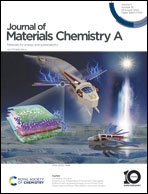Fully sp2-carbon connected polymeric frameworks with rotatable conformation-enhanced lithium-storage performance†
Abstract
Conjugated porous polymers are emerging as sustainable and reliable electrode materials for lithium-ion batteries, owing to their versatile chemical modification, environmental-friendliness, and low cost, but still suffer from insufficient redox-active sites and sluggish ion/electron transport. Here, two new kinds of porous polymers (denoted as TPT-CMP and BFT-CMP), comprising full sp2-carbon skeletons connected through vinylidene linkages, are synthesized by acid-catalyzed Knoevenagel condensation of ethene-1,1,2,2-tetrayl-tetrakis-1,1′-biphenyl-4-carbaldehyde and 9,9′-bifluorenylidene-3,3′,6,6′-tetrayl-tetrabenzaldehyde with s-indacene-1,3,5,7-(2H,6H)-tetraone, respectively. Such porous polymers were readily composited with carbon nanotubes to form freestanding thin films upon a simple vacuum-assisted filtration. As the anode, the TPT-CMP-based film delivered a much higher capacity of 550 mA h g−1 at 100 mA g−1 than the BFT-CMP-based one (407 mA h g−1), although TPT-CMP exhibits a much lower surface area of 535.92 m2 g−1 than that (934.41 m2 g−1) of BFT-CMP. This phenomenon might be attributed to the idea that the conformationally rotatable tetraphenylethylene moieties in the case of TPT-CMP might improve rapid mass transport. Both composite electrodes can sustain 500 cycles without any significant decay. These results set new capacity records among porous polymer-based lithium-ion batteries and suggest a new method for achieving promising anode materials by rationally designing the main backbones of conjugated porous polymers.



 Please wait while we load your content...
Please wait while we load your content...